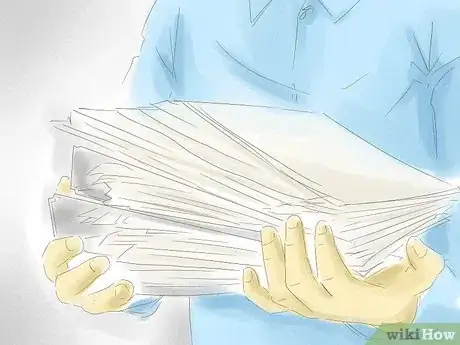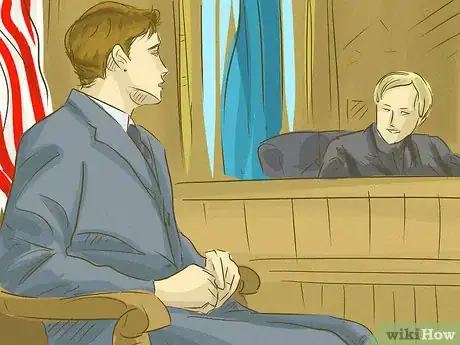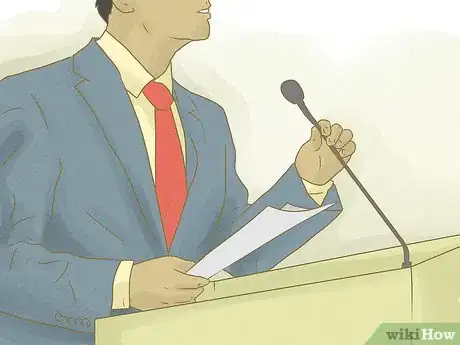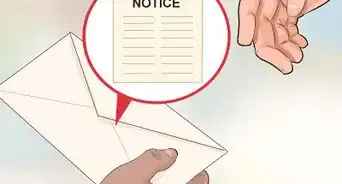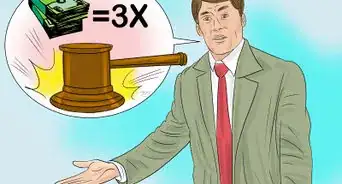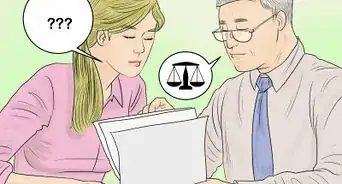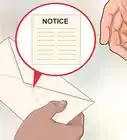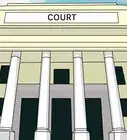This article was co-authored by Clinton M. Sandvick, JD, PhD. Clinton M. Sandvick worked as a civil litigator in California for over 7 years. He received his JD from the University of Wisconsin-Madison in 1998 and his PhD in American History from the University of Oregon in 2013.
There are 11 references cited in this article, which can be found at the bottom of the page.
This article has been viewed 68,341 times.
Libel occurs when a person or entity communicates a false and defamatory statement that damages the reputation of another person or entity. Unlike slander, which is spoken, libel is written and published so that it can be seen by others. The laws surrounding libel and slander are practically identical in most jurisdictions, and often known collectively as defamation. You can prove libel by demonstrating that someone wrote and shared false and defamatory statements about you, which harmed your reputation.
Steps
Understanding the Legal Definition of Libel
-
1Be aware of the proof required to prove libel. In order for a statement or a written communication to qualify as libel, it must contain certain elements. A statement is not legally libel unless it meets all of the following criteria:[1]
- The statement must be false. In order to be libel, the communication or statement must be untrue. It is your burden to prove that the person told a lie about you. The statement also must be a statement of fact that can be proven one way or another, and not a mere personal opinion. Simply stating that a person's hair looks terrible is not defamation, even if it is untrue; rather, such a statement is merely your opinion. A statement that is obvious hyperbole also is not grounds for libel, since the recipient reasonably should know that the statement is false. For instance, stating that "she complained about the customer service that she received a million times" is a hyperbole, since it is clear that she couldn't literally complain a million times.
- The statement must have caused defamation or damage to your reputation. It is not enough that the statement hurt your feelings or made you feel bad. There must be actual damage to your reputation that is measurable in monetary damages. For instance, if the statement caused you to lose a job, you may be able to prove that you are entitled to monetary damages. If the statement caused you to lose business from a particular customer, then you might have a valid claim for damages.
- The person must have published the defamatory statement to a third party. In order to prove libel, you must be able to show that at least one other person besides you received or read the communication that you believe is false and defamatory. This could have occurred through the media, a letter, an email, or even a social networking post.
- The defamatory statement must obviously be about you or a particular person. Detail the reasons you know that statement was about you. It will be easy to prove if the person used your name. If your name was not used, demonstrate how you and other people would know that the statement was about you. For instance, consider whether the statement identifies a a particular characteristic that is unique to you. Those who read the communication must know who it is defamatory to you.
-
2Understand that there are additional requirements for a public figure to prove libel. The public has the right to criticize the government or other public figures. As a result, the proof for libel of a public figure is far greater and very difficult. Specifically, you must prove that the person who made the statement did so with actual malice, or acted in reckless disregard for the truth of the statement.[2]
- American courts have ruled that politicians, entertainers, well-known athletes, writers, and others who are established in the media are all considered to be public figures.
Advertisement -
3Realize that some types of statements always constitute libel. In this kind of situation, there is no need for you to be able to show specific monetary damages or that harm occurred to your reputation. These examples of statements are simply libelous on their face:[3]
- Accusations of having committed a crime
- Accusations of having a contagious and socially unacceptable diseases, such as a sexually transmitted disease
- Accusations of someone committing adultery or other sexual misconduct, having a drug or alcohol addiction, being mentally ill, or being dishonest and bigoted
- Accusations of someone being “unfit” for his or her job or trade
-
4Know that there are time limits to file a libel lawsuit. Like any other lawsuit, there are specific time limits in which you must file your libel claim. These time limits, or statutes of limitation, vary from one state to the next, but the average time limit is about one to two years from the time that the defamatory statement occurred.[4]
Gathering Evidence in Support of a Libel Claim
-
1Document all details. If you think a person or a publication has committed libel against you, document everything as soon as you become suspicious. Make a timeline of events, and save or print copies of the places where the defamation was communicated about you. Keep a list of witnesses who read the false and damaging statements, and make sure they are willing to testify to what they read.
-
2Anticipate defenses to a libel claim. The most common defense to libel is a claim that the statement in question is true. Therefore, you will need to collect evidence that proves the statement is false.[5]
- For instance, suppose that a person who wrote an online review of a restaurant stated that she found a dead mouse in her spaghetti. You could get statements from anyone else who was dining in the restaurant at the same time, the cook who prepared the spaghetti, and the waiter who served the spaghetti that there was not a dead mouse in the woman’s spaghetti.
-
3Gather evidence in support of your claimed damages. You must prove actual damage to your reputation that is quantifiable in some way as a result of the statement. This means that you must be able to place a monetary value on the damages that you have sustained due to the allegedly libelous publication. There are four different forms of evidence that can be presented in a libel suit:[6]
- Documentary evidence is any written or paper evidence presented at trial. For instance, you could show that the statement caused you to lose your job, which was your only source of income, by presenting paycheck stubs, your federal and state income tax returns from prior years, and documentation of your last day of employment.
- Testimonial evidence is oral testimony by a party or witness. For example, your former supervisor might testify that you lost your job because of the libelous allegation that you had committed a crime.
- Physical evidence is an actual object introduced as evidence. For instance, you might use the defendant's laptop as evidence that he or she used it to publish a false statement about you on social media.
- Demonstrative evidence illustrates or represents other evidence presented at trial. For example, you might use a PowerPoint presentation to show a timeline when important events related to your libel claim occurred.
-
4Ensure that the statement was not privileged. Even if a statement is false, it is not libel if it was a privileged, or legally protected, statement. There are some circumstances where the First Amendment of the U.S. Constitution, which protects free speech, also protects people who make libelous statements from lawsuits. These situations usually involve court proceedings in which witnesses are placed under oath and sworn to tell the truth.[7]
- For instance, a witness who makes a false statement during a deposition in connection with a lawsuit cannot be sued for defamation. However, the witness could be prosecuted for perjury.
Filing a Libel Lawsuit
-
1Seek the advice of an attorney who specializes in defamation suits. A legal professional can advise you on whether you have a strong enough case to sue for libel. Because defamation cases can be difficult, it is essential that you have a qualified attorney to advocate on your behalf.
-
2Prepare the complaint. The complaint is the document that sets forth the grounds for your libel lawsuit. You will have to include the false statement that was made about you, who made it, and where and when it was made. Your complaint also must show that the statement was published and that you suffered injury as a result of the statement.[8]
- When you file a lawsuit, you are the plaintiff. The person against whom you are filing the lawsuit is the defendant.
- Rules for filing any type of civil lawsuit vary widely from one state to another, and even from one court to another. You will need to look at your state’s civil trial rules and procedures, as well as any local court rules, in order to ensure that your paperwork is in the proper format.
- The court may also require you to file additional paperwork aside from a complaint. Check with your local clerk of court’s office to see if they have other forms that you must fill out when filing a lawsuit.
-
3File the complaint and multiple copies with the proper court. The court for the jurisdiction in which the libelous statement occurred would be the court in which it is proper to file your libel claim. However, a court in the jurisdiction in which the libelous statements were published might also have jurisdiction to hear the suit.[9]
- Most court paperwork is filed in the clerk of court’s office for that particular court. If you need to submit paperwork elsewhere, the clerk’s office can direct you.
- You should retain a copy of all of the paperwork that you file with the court for your records. If you give the clerk’s office an additional copy of your complaint when you file it, for example, the clerk will file-stamp it for you. This gives you verification of the filing of your lawsuit.
-
4Pay the necessary court fees. Court filing fees differ dramatically from one jurisdiction to the next, but tend to run between $100 and $300. You typically will need to pay the filing fee in cash or with a certified check or money order. Court usually do not take personal checks.
-
5Arrange to have the defendant served with notice of your lawsuit. Your lawsuit cannot progress until you properly serve the defendant according to your state’s rules of procedure. This step gives the defendant a chance to become aware of and respond to your lawsuit. The clerk’s office will help carry out the form of service that you choose.
- Because you are a party to the lawsuit, you cannot serve the defendant with notice yourself.
- You may be able to serve the defendant by certified mail. The clerk’s office typically charges a small fee, which should be about $10, to serve the defendant in this way.
- You may be able to use personal service. This means that a person, who usually works for the sheriff of the county in which you are filing your lawsuit, will personally hand a copy of the lawsuit to the defendant. Your local sheriff’s department usually charges a fee, which can range from $10 to $100, to personally serve a defendant.
- If you cannot find the defendant’s address or otherwise locate him or her for service, the court may permit you to carry out service by publication. In this type of service, you publish notice of the lawsuit in the local newspaper for a specified period of time. You may be required to publish notice more than once. There is a fee charged by the newspaper for publication, usually ranging between $50 and $100. Service on the defendant is then valid, whether he or she actually sees the notice or not.
-
6Engage in the discovery process. Every lawsuit allows each side to the dispute to request evidence from the opposing party. Discovery takes a number of forms:[10]
- Requests for production of documents
- Interrogatories, or answers to written questions
- Depositions, in which a party or a witness has to answer questions in person and under oath
- Requests for admission, which ask the other party to admit under oath that certain facts about the lawsuit are true
Resolving Your Libel Lawsuit
-
1File a motion for summary judgment. Depending on your case, it may be appropriate for you or the defendant to file this motion, which asks the court to go ahead and making a ruling on the libel claim based on the law. In this type of situation, there is no dispute as to the facts.[11]
-
2Negotiate a settlement of your case. If you are able to reach a settlement with the other party about your libel lawsuit, it may be a good idea in more ways than one. Trials can be expensive and very time-consuming. Additionally, there are no guarantees of a positive outcome. Meeting with the other party in order to try and work out a settlement is always worth a shot.
-
3Engage in alternative dispute resolution. The court system has increasingly turned to various forms of alternative dispute resolution to settle legal disputes. These are cheaper and more efficient ways to resolve cases without proceeding to trial. In some cases, courts require that you go through a certain type of alternative dispute resolution before a case goes to trial. There are a few different types of alternative dispute resolution that courts primarily use.[12]
- In mediation, the parties meet with a neutral third party who is trained to help parties resolve disputes. The mediator is not on either party’s side. He or she is simply there to help each side discuss the issues, weigh the pros and cons of a possible settlement, and try to reach a middle ground that is satisfactory to both parties.
- Arbitration is similar to a trial, but is a much more informal proceeding. In arbitration, both sides have the chance to present evidence and testimony to a neutral third party, who is called an arbitrator. Unlike a mediator, however, an arbitrator will make an award or decision about the case, and his or her decision typically is binding on the parties. This means that whatever the arbitrator says goes.
-
4Proceed to trial on your libel claim. If the parties cannot reach a settlement, the case must proceed to a trial. The trial can be in front of the judge or a jury.
-
5Choose a jury, if applicable. If the suit involves a jury trial, the attorneys for both sides of the dispute will take turns picking jurors from a pool of available jurors who have been called for jury duty. Each attorney will have the chance to ask the court to excuse some jurors from the trial.
- The process of choosing a jury is referred to as voir dire. The purpose of voir dire is to determine if any juror has a personal interest in the case or a prejudice that may wrongfully influence him or her during the trial.
-
6Give an opening statement. The plaintiff’s attorney gets to go first and introduce the case to the jury. The defendant’s attorney then has the same chance to do so. Each side will tell the jury what the case is about and what the evidence will prove.
-
7Call and question witnesses. First, the plaintiff’s attorney will call different witnesses to the stand and question them about the dispute. This is referred to as direct examination. After the direct examination of each witness, the defendant’s attorney will also question the witness, in a process referred to as cross-examination. Next, the defendant’s attorney will call his or her witnesses, and the plaintiff’s attorney, likewise, will have the chance to cross-examine them.
-
8Give closing arguments. Each side’s attorney will end the case by giving his or her closing argument, which summarizes the trial and the evidence. It is the last chance that an attorney will have to address the judge and jury.
-
9Receive a verdict. Once all evidence has been presented by both sides, the jury will meet behind closed doors, review the evidence, and make a decision on the case. These proceedings are normally referred to as jury deliberations. Once the jury reaches a decision, they will announce it to the judge and both parties.
References
- ↑ http://dictionary.findlaw.com/definition/libel.html
- ↑ http://injury.findlaw.com/torts-and-personal-injuries/defamation-libel-and-slander-background.html
- ↑ http://injury.findlaw.com/torts-and-personal-injuries/what-is-defamation-per-se-.html
- ↑ http://injury.findlaw.com/torts-and-personal-injuries/time-limits-to-file-a-defamation-lawsuit-state-statutes-of.html
- ↑ http://injury.findlaw.com/torts-and-personal-injuries/defenses-to-libel-and-slander.html
- ↑ http://www.alllaw.com/articles/nolo/personal-injury/evidence-defamation-lawsuit.html
- ↑ http://injury.findlaw.com/torts-and-personal-injuries/elements-of-libel-and-slander.html
- ↑ http://litigation.findlaw.com/filing-a-lawsuit/how-to-sue.html
- ↑ http://litigation.findlaw.com/filing-a-lawsuit/how-to-sue.html






